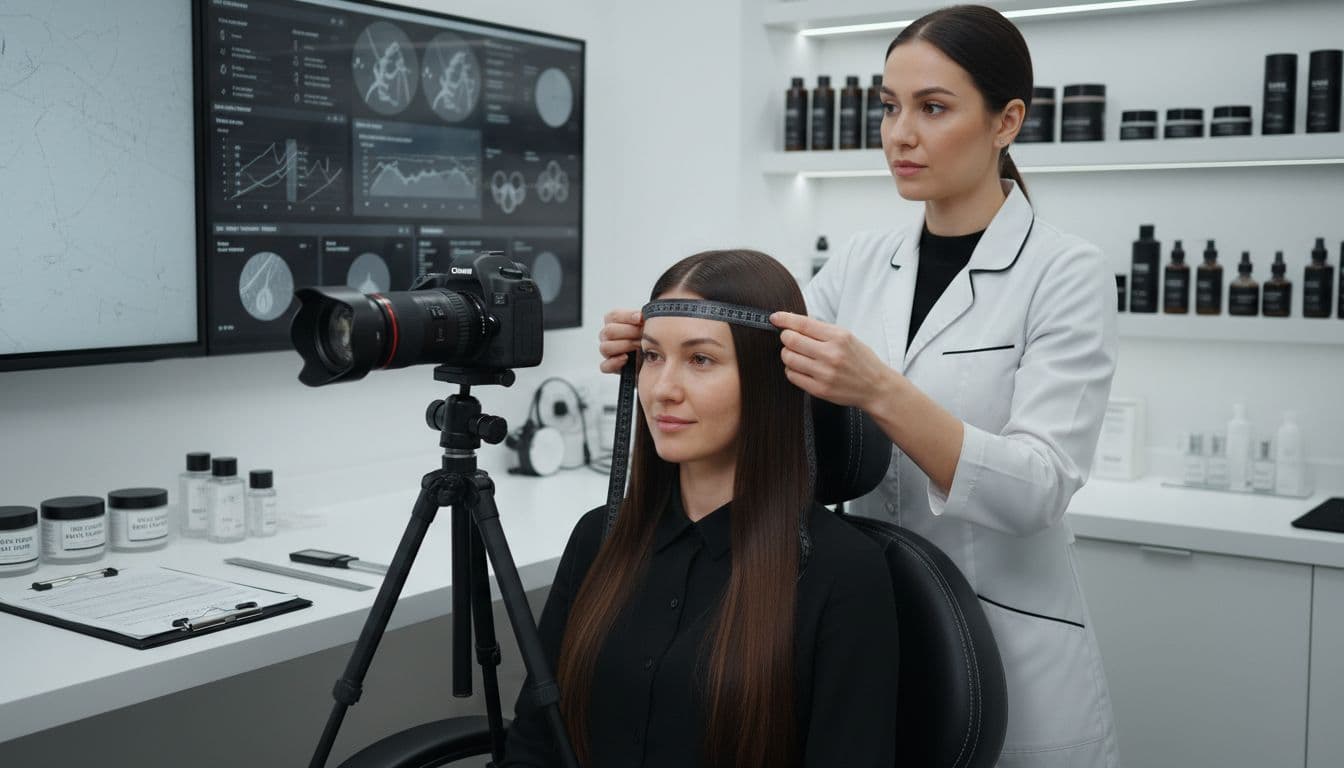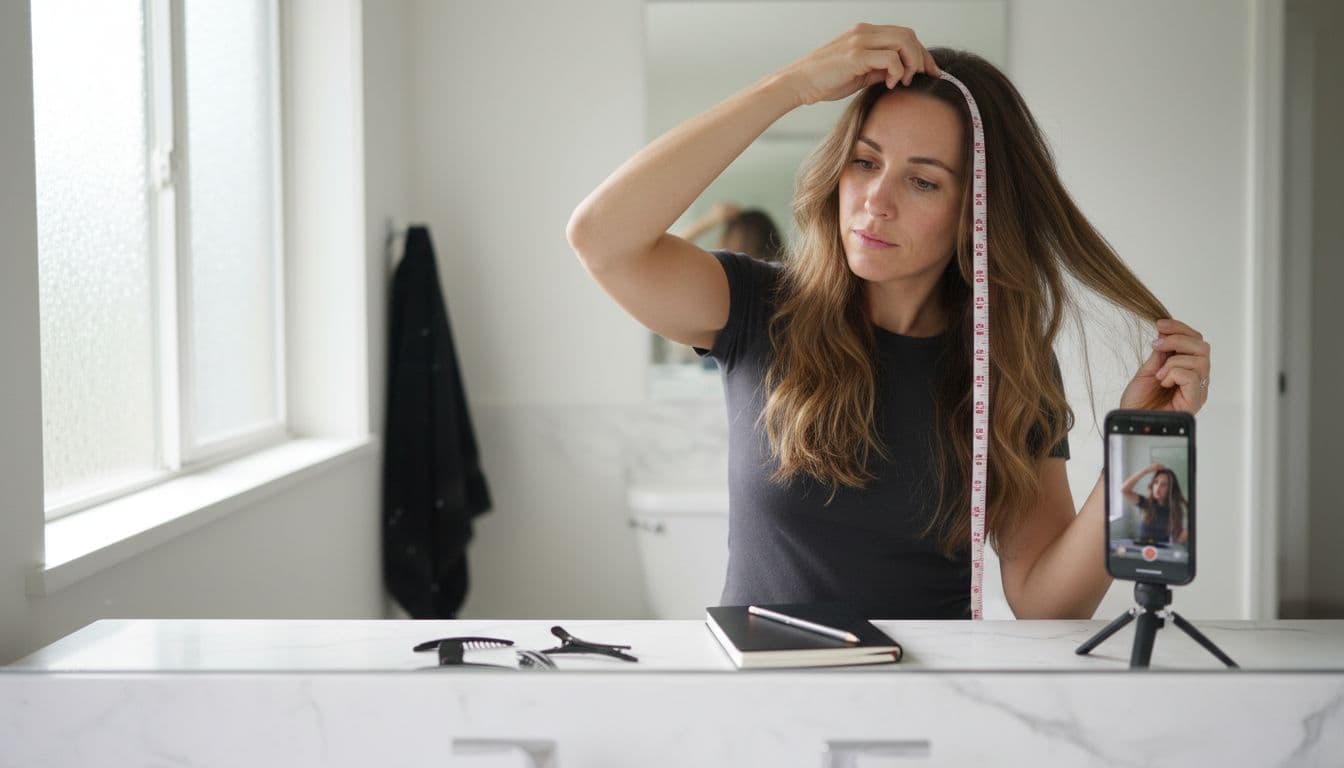Blog
Learning Materials
Cómo hacer un seguimiento del crecimiento del cabello: Complete Guide
Updated: November 15, 2025

More than 80 percent of people who track their hair growth find it difficult to get reliable results. If you want to see real progress, knowing exactly where you started makes all the difference. Building an accurate baseline and documenting your journey step by step can turn vague hopes into measurable improvements. This guide breaks down practical methods for preparing, measuring, and analyzing your hair so you get clear, consistent answers every month.
Table of Contents
- Step 1: Prepare Your Hair For Accurate Baseline Measurement
- Step 2: Capture Initial Hair Condition Using Photos Or Scans
- Step 3: Track Growth Progress With Consistent Monthly Updates
- Step 4: Analyze Trends Using Ai-Based Tools And Personal Logs
- Step 5: Verify Growth Results And Adjust Your Hair Care Routine
Quick Summary
| Key Point | Explanation |
|---|---|
| 1. Prepare hair correctly for measurements | Wash hair with mild shampoo 24-48 hours prior and avoid products to ensure accurate baseline measurements. |
| 2. Capture initial hair condition with photos | Use consistent lighting and angles to document your hair and scalp, creating a visual baseline for future comparisons. |
| 3. Track growth with monthly measurements | Measure hair length consistently each month and record findings to identify growth patterns and track progress effectively. |
| 4. Analyze trends using technology | Utilize AI-powered tools and personal logs to gain insights on hair health and growth patterns, improving tracking accuracy. |
| 5. Verify results and adjust routine accordingly | Regularly compare growth measurements to your baseline and modify your hair care routine based on consistent trends over time. |
Step 1: Prepare your hair for accurate baseline measurement
Capturing an accurate hair growth baseline starts with proper hair preparation. This crucial first step ensures your measurements will be precise and meaningful, giving you a reliable starting point for tracking your hair's progress.
According to Wholesale System Healing, the key is to wash your hair with a mild shampoo within 24 to 48 hours before taking your sample. This timing helps remove surface dirt and excess oils while maintaining your hair's natural state. When preparing for your baseline measurement, avoid using conditioners or styling products immediately before sampling, as these can interfere with the accuracy of your assessment.
To get the most reliable results, follow these specific preparation steps:
- Wash hair with a plain, mild shampoo
- Allow hair to dry completely
- Avoid using any leave-in products or styling tools
- Ensure your scalp and hair are clean and free from residue
For the most precise measurements, Interclinical recommends cutting small samples from multiple areas of your scalp. This approach provides a more comprehensive view of your hair's overall condition and growth potential.
With your hair properly prepared, you are now ready to move on to the actual measurement and tracking process.
![]() The groundwork you've just completed will ensure that your baseline reading is as accurate and informative as possible.
The groundwork you've just completed will ensure that your baseline reading is as accurate and informative as possible.
Step 2: Capture initial hair condition using photos or scans
Tracking your hair growth journey begins with capturing a comprehensive baseline visual assessment. This critical step provides a clear reference point for monitoring future changes and understanding your hair's unique characteristics.
According to Better Scalp Company, standardized scalp mapping involves capturing high-resolution images under consistent lighting conditions. To get the most accurate documentation, you'll want to use a systematic approach that captures multiple angles and perspectives of your scalp and hair.
Here are some key guidelines for capturing your initial hair condition:
- Use natural, consistent lighting (preferably indirect daylight)
- Take photos from multiple angles: front, back, and both sides
- Use a clean background that provides clear contrast
- Keep the camera at the same distance and height for each shot
- Ensure your hair is styled similarly in each photo
Pro tip: Consider using a ruler or reference object in your initial photos to help track precise measurements in future comparisons. This will give you a more scientifically accurate way to monitor subtle changes over time.
With these detailed photos now captured, you have established a robust baseline for tracking your hair growth journey. These images will serve as your personal reference point, allowing you to see subtle transformations that might otherwise go unnoticed.
Step 3: Track growth progress with consistent monthly updates
Monitoring your hair growth journey requires a systematic and disciplined approach to measurement and documentation. Creating a reliable tracking system will help you understand your hair's unique growth patterns and progress over time.
According to Smytten, effectively monitoring hair growth means measuring your hair length monthly using a consistent method such as a ruler or measuring tape. Certified Cosmetics recommends conducting measurements over a 4 to 8 week period to provide statistical analysis of your hair's density changes.
To create an effective monthly tracking routine:
- Choose a specific day each month for measurements
- Use the same measuring tool (ruler or tape measure)
- Measure from the scalp to the hair tips
- Record measurements in a dedicated notebook or digital spreadsheet
- Take photos from the same angles as your initial baseline images
Pro tip: Be consistent with your measurement technique. Always measure when your hair is straight and dry to ensure accuracy and comparability across different tracking periods.
By maintaining this structured approach, you will transform your hair growth tracking from guesswork to a precise science. Your monthly updates will reveal subtle changes and provide motivation as you progress on your hair growth journey.

Step 4: Analyze trends using AI-based tools and personal logs
Transforming your hair growth tracking from a simple measurement process into a comprehensive analysis requires leveraging advanced technological tools and maintaining detailed personal records. This step will help you gain deeper insights into your hair's unique growth patterns and potential.
Recent research from ArXiv highlights emerging technologies like DiffLocks, a framework that can generate detailed 3D hair geometry from a single image using advanced diffusion models. While such cutting-edge technologies demonstrate the potential of AI in hair analysis, you can start with more accessible tools to track your progress effectively.
To create a comprehensive trend analysis:
- Digitize your monthly measurements in a spreadsheet
- Use AI-powered hair tracking apps that can visualize growth
- Compare photos side by side to observe subtle changes
- Note environmental factors that might impact hair growth
- Look for patterns in density, length, and overall hair health
Pro tip: Consistency is key. The more detailed and regular your logs, the more accurate your trend analysis will become. Consider creating a digital journal that tracks not just measurements, but also factors like diet, stress levels, and hair care routines.
By combining technological tools with meticulous personal logging, you transform hair growth tracking from a passive observation to an active, insightful process. These trends will help you make informed decisions about your hair care strategy.
Step 5: Verify growth results and adjust your hair care routine
Verifying your hair growth results is a critical step in understanding the effectiveness of your current hair care approach. By systematically analyzing your progress, you can make informed decisions that optimize your hair health and growth potential.
According to Smytten, regularly measuring your hair growth allows you to assess the effectiveness of your hair care routine. Certified Cosmetics emphasizes that hair density measurement tests provide measurable evidence of product performance, enabling precise adjustments to your care strategy.
Here are key steps to verify and adjust your hair growth routine:
- Compare your current measurements to your baseline images
- Analyze density changes and length progression
- Identify successful elements of your current routine
- Research alternative strategies for areas showing minimal improvement
- Consult with hair care professionals for personalized advice
Pro tip: Do not make drastic changes based on a single month's results. Look for consistent patterns over 3 to 6 months before making significant modifications to your hair care approach.
By approaching your hair growth journey with a scientific and patient mindset, you transform random hair care into a targeted, data driven strategy. Your commitment to careful observation and adaptation will be the key to achieving your hair growth goals.
Take Control of Your Hair Growth Journey with Precision and AI
Tracking hair growth can feel overwhelming when trying to manage measurements, photos, and progress analysis all on your own. This article highlights how important consistent baseline measurement, monthly updates, and detailed trend tracking are to truly understanding your hair health. If you face challenges like maintaining accurate records, detecting subtle changes, or verifying your progress scientifically, you are not alone. Many experience frustration trying to interpret their hair growth signals without expert guidance or sophisticated tools.
MyHair.ai solves these problems by providing AI-based hair health analysis that gives personalized insights based on your own hair scans. Our platform makes complex tracking easy by offering tailored growth projections and clear product recommendations crafted for your unique hair condition. Imagine having a professional-level monitoring system at your fingertips, simplifying every step from baseline capture to trend evaluation.

Discover how you can turn uncertainty into confidence. Visit MyHair.ai to start uploading your scans and receive detailed assessments that empower your hair care decisions. Explore how our AI technology complements the steps from your hair growth guide and unlocks a new level of insight and support. Your hair deserves the best tools to thrive — take action today and watch your progress unfold with clarity and precision.
Frequently Asked Questions
How can I accurately measure my hair growth?
You can accurately measure your hair growth by using a ruler or measuring tape to track the distance from your scalp to the hair tips. Set a specific day each month for this measurement and record the results to note progress over time.
What steps should I take to prepare my hair for baseline measurement?
To prepare your hair for an accurate baseline measurement, wash it with a mild shampoo within 24 to 48 hours before sampling, and avoid styling products. Ensure your hair is completely dry and clean to achieve a reliable starting point for tracking.
How often should I take photos to track my hair's growth?
You should take hair growth photos at least once a month to maintain a consistent visual log of your progress. Use natural, consistent lighting and capture images from multiple angles to ensure a comprehensive reference.
What factors should I consider when analyzing my hair growth trends?
When analyzing your hair growth trends, look at patterns in density, length, and overall health, as well as any environmental factors that might affect your hair. Maintain a detailed log to help identify trends and make informed adjustments to your care routine.
How can I verify the effectiveness of my hair care routine?
To verify your hair care routine's effectiveness, compare your current measurements and photos with your baseline data. Look for consistent patterns over 3 to 6 months to assess whether adjustments are needed instead of making changes based on short-term results.
What should I do if I see minimal hair growth after several months?
If you observe minimal hair growth after several months, evaluate the elements of your current hair care routine and consider researching alternative strategies. Consult with hair care professionals for personalized advice that can help optimize your growth potential.